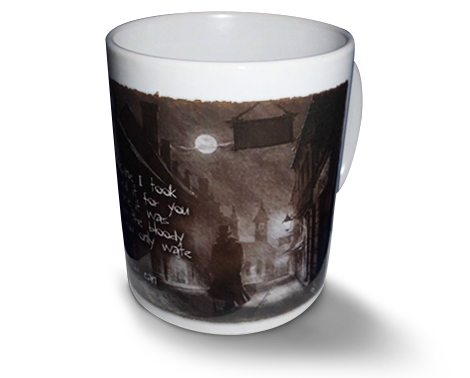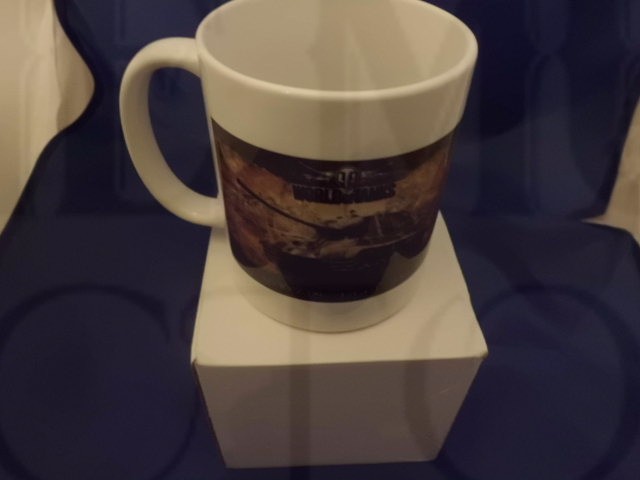World Of Tanks JagdTiger military mug
11oz mug
World Of Tanks JagdTiger Jagdtiger ("Hunting Tiger") is the common name of a German heavy tank destroyer of World War II. The official German designation was Panzerjäger Tiger Ausf. B as it was based on a lengthened Tiger II chassis.
Jagdtiger was the heaviest and arguably the most powerful armoured fighting vehicle to see service during the Second World War. Although it was a formidable defensive weapon Allied bombing restricted production. Very few were built and they only saw combat in the final weeks of the war. The vehicle’s size, a shortage of fuel and poor crew training further limited its impact.The origins of the Jagdtiger stretch back to February 1943, when Hitler ordered the production of an assault gun or tank destroyer armed with the 12.8cm gun. This weapon was desired by frontline troops as it would offer unparalleled firepower against armoured and unarmoured targets at ranges of up to 3000m.The Jagdtiger hull was based on that of the Tiger II tank, being built by Henschel. The larger gun, however, meant the hull needed to be lengthened by 40cm. On the 20th October 1943 Hitler inspected a full scale wooden mockup at Arys Proving Ground, and approved an order for 150. Porsche’s Nibelungenwerke was given the contract. Production began in December, with the first two vehicles finished by February 1944.Exactly 6 months after he had inspected the mockup, Hitler returned to Arys on the 20th April to see a demonstration of the finished vehicle.Although the Jagdtiger was based on the Tiger II, which already had a perfectly satisfactory suspension, Ferdinand Porsche tried to convince Hitler that this should be replaced with his own system. This was a modular design that Porsche had attempted to use on all his heavy tank designs, dating back to his original proposals for the Tiger I in 1941. It used self-contained bolt-on units each fitted with two road wheels and a short torsion bar running longitudinally. Four would be fitted to each side of the Jagdtiger.Henschel’s suspension used transverse torsion bars that ran across the bottom of the hull inside the vehicle. Porsche argued that his system was quicker, easier and cheaper to manufacture, largely because the holes in the hull these bars fitted into had to be machined very accurately in order for them to fit, whereas his system simply bolted on. Two vehicles, one fitted with each system, were evaluated by the Army from May 1944. They decided against Porsche’s system for a number of reasons. This included the potential for the bolts to fail, causing an entire unit to shear off under heavy load. The system also had fewer road wheels, 16 single wheels as opposed to 18 double wheels. More wheels gave improved track control as well as exerting lower pressure on the track and therefore causing less wear. Porsche suspension vehicles were produced until September, with 1 unarmoured prototype and 11 production vehicles built in all.Jagdtigers were powered by the same Maybach HL 230 P30 engine as used in the Panther and both Tigers. As the Jagdtiger was far heavier than these tanks, but the engine was no more powerful, generating 700HP, the vehicle’s speed, range and mobility across country were all reduced. The vehicle’s weight also placed extra strain on the engine, transmission and drivetrain, increasing failure rates. The fighting compartment was a large, boxy superstructure protected by formidable thicknesses of armour. The front plate was 200mm thick, enough to render the vehicle invulnerable to Allied anti-tank guns. This protected the gun, ammunition and four of the crew, the commander, gunner and 2 loaders. The driver and wireless operator were stationed in the hull, under 150mm of armour. Side armour was thinner, at 80mm.The 12.8cm PaK 44 gun, firing the PzGr 43 APCBC-HE armour piercing round, could destroy any Allied tank at ranges far beyond their ability to respond. The other ammunition available was the Spr Gr L/50 High Explosive round. The gun used two part ammunition, the shell being loaded separately to the propellant case. Mounted in the Jagdtiger, it had a maximum traverse of 20 degrees with elevation from -7 to +15 degrees. A total of 38 rounds could be carried.As a contingency against shortages of the 12.8cm gun, plans were made to fit the less powerful, but still formidable 8.8cm PaK 43 from the Jagdpanther. It appears that at least 4 Jagdtigers were armed with this weapon, but they saw no combat service.During October 1944 the first of two combat units to field the Jagdtiger, Heavy Tank Destroyer Battalion 653, began to receive its first vehicles. Over the rest of the year they continued to train and build up to a strength of 42 Jagdtigers. The first use of the Jagdtiger in combat was on the 9th January 1945, when 3 took part in an attack near Rimling on the Franco-German border, part of Operation Nordwind. One was lost.The first large scale fighting to involve the Jagdtiger took place during March around Hagenau, as the Allies crossed the Moder River. This defensive fighting suited the Jagdtiger’s design perfectly and the Germans were able to inflict heavy losses at long range on the Americans. Their armour was thick enough to protect them from return fire.Most Jagdtigers lost fell victim to mechanical failure rather than enemy action. Crews tried to recover as many vehicles as possible for repair, but often Allied forces overran the disabled vehicle and it had to be abandoned. Crews were issued with demolition charges so that vehicles in this position could be destroyed. The loss rate was very high. As an example, on the 15th March the Battalion had 41 Jagdtigers, 3 of which needed repair, but two weeks later only 3 were operational from a total of just 25. By this stage, they tended to be used in small, improvised Kampfgruppen, or combat groups, rather than formal units. Heavy Tank Destroyer Battalion 653’s remaining personnel and their final 2 Jagdtigers surrendered to the Americans at Liezen in Austria on the 7th May.During January 1945 Heavy Tank Destroyer Battalion 512 began to form, the only other front line unit to use the Jagdtiger. During February 1945 a serious mechanical fault was discovered in the Jagdtiger’s Henschel L801 steering unit. The units all had to be replaced, a difficult and time consuming job. This had an effect on the availability of vehicles in Battalion 653, and delayed the formation of Battalion 512 until March.Vehicles from this Battalion were first used in combat on the 24th March north of Remagen. Battalion 512 had a similar experience to their comrades in Battalion 653. Jagdtigers were used in small combat groups, inflicting heavy losses on American forces, but never succeeding in stopping their advance. A number of vehicles fell victim to mechanical failure and had to be abandoned. During March and April the battalion fought to try and escape the Ruhr pocket. They failed and the final remnants of the unit surrendered at Iserlohn on the 16th April.The final use of the Jagdtiger seems to have been on the 5th May at Strengberg near the Nibelungenwerke, when 3 vehicles and their crews surrendered to both American and Soviet forces.Production of Jagdtigers had stopped on the 4th May, and on the 9th the Soviets captured the Nibelungenwerke. Sources differ on the exact number of vehicles completed, but it was around 85.This VehicleThe Tank Museum’s Jagdtiger has chassis no. 305004. It was one of eleven (plus an unarmoured prototype) which were fitted with the Porsche suspension system. It was built in July 1944 and sent to the Sennelager testing ground just north of the city of Paderborn in August, where it was used for trials. It was never assigned to a combat unit. Towards the end of March 1945 units of the American XIX Corps were advancing towards Paderborn. The Germans assembled as many armoured units as they could to try and fend off their attack. One of these was an improvised unit called Panzergruppe Paderborn manned by instructors and equipped with an assortment of vehicles from test units, including Tiger Is, Tiger IIs, Panthers and even an old Panzer III. It is unclear whether the Jagdtiger was also a part of this force, or whether it took any part in the fighting. Fighting around Paderborn and Sennelager continued for around a week. Although the German forces in and around the training area put up heavy resistance, most American units simply bypassed them to the north or south. By the 5th April it was clear that the forces left had to withdraw or risk being cut off. The Museum’s Jagdtiger was abandoned and the next day it was captured by the Americans. It was photographed almost immediately afterwards by a photographer attached to XIX Corps. After the war Sennelager became part of the British Zone of Occupation. Both the Jagdtiger and the Pre-production King Tiger now in the Tank Museum were seen at Haustenbeck by British Ministry of Supply Researchers on the 25th August 1945. The Jagdtiger was tested at Sennelager (with some of this captured on film). It was then moved to the School of Tank Technology at Chertsey in the UK for further testing before arriving at the Tank Museum in 1952. During the 1960s and 1970s a handrail was welded onto the roof and visitors could stand on top of the vehicle. This was later removed, but the mounting brackets were not. During November 2016 the vehicle was moved for the first time in as many as 50 years. In February 2017 it was repainted in the original Dunkelgelb paint scheme it wore when captured.It is missing its rear engine plate cover and the third left-hand suspension unit but still retains its original Zimmerit anti-magnetic mine paste.ReferencesJentz, T. Panzer Tracts No. 9 – JagdpanzerDevey, A. Jagdtiger Volume 1 – Technical HistoryDevey, A. Jagdtiger Volume 2 – Operational History
On 16th December 1944 the newly formed German 6th Army started a new offensive aimed at capturing the port of Antwerp. They made a surprise attack through the Ardennes and soon surrounded the strategically important Belgium city of Bastogne on 19th December 1944.
The winter weather was bad. Snow and ice roads hindered the Americans. They drove through following day and night to reach the Bastogne area. Thirty two tanks of the 8th battalion reached the outskirts of the city within 24 hours of receiving their orders to move off. The Germans had blown a bridge which delayed the advance as they had to clear the surrounding woods before the engineers could construct a temporary pontoon bridge for the tanks to cross.
On the morning of 23rd December 1944, blocking their way into Bastogne was the defended village of Chaumont. They were fired upon as they approached it at first light. Major Al Irzyk devised a pincer movement plan of attack, C Company would circle around to the left, A company would circle around to the right whilst he would lead B Company on a frontal assault of the village. He recalls, "Now if I was at Fort Knox, Kentucky taking a tactics course I probably would have gotten an ‘A’ grade for my plan. As you know in combat there are the imponderables of the battlefield.""C company reports to me that five of its tanks in its first platoon were completely bogged down. This ground was supposed to be frozen so right away I knew C Company was going to be of no help. So B Company started to advance down onto the town. We were hitting resistance but it was not major resistance. Armoured infantry were working with us. When we got down into town they would go down to the buildings or into them where the German soldiers were. B Company gets through the town and then the heavens open up. All hell breaks loose.
Major Albert Irzyk and his tanks had driven into a carefully planned ambush. "It was a platoon of four Jagdtigers. Bang, bang, bang all over the place. Tanks in front of me had been hit. B Company was downtown and you cannot turn because of the narrow streets so we are very vulnerable. I told my driver to start backing up. Now he was backing up blind. He needs some help from me. To move back out I had the turret turned to face backwards so I could direct the driver but this exposed the back of our turret to the enemy which made it very vulnerable. I began to breathe a bit easier when it seemed we were out of range. When suddenly I heard this loud screeching sound just for an instant. The whole tank was pushed forward as if a sledge hammer had hit it."
"A 128mm shell, which should have breezed through the turret like a hot knife through butter, must have hit and bounced off. I shouted at the driver, ‘keep going’. As we were moving back I noticed there was a seam in the tank turret with daylight showing through it so I knew something had hit the turret. We finally pulled the tank out of range. I asked myself the question. Why are we still here? Why did my tank survive this battle when it had had this terrible terrible blow? Next to the antenna well there was an appendage. The Jagdtiger’s 128mm shell hit it and was deflected.





